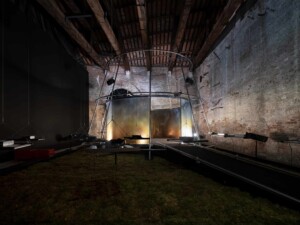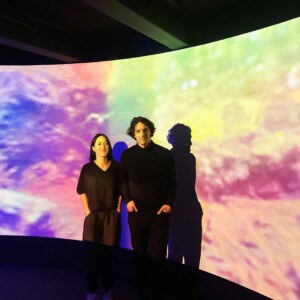
Turba Tol Hol-Hol Tol, a collective project on display as part of the 59th Venice Biennale, features an interdisciplinary team of Chilean creatives, including Alfredo Thiermann, design critic in Architecture at the Harvard Graduate School of Design. The pavilion is a multisensory sound and video installation that exhibits the cultural, political, and environmental relevance of the peatlands in Patagonia and their relationship with their original inhabitants, the Selk’nam people. Turba Tol Hol-Hol aims to provide an experimental path toward conserving the peatlands through research, education, and collaborations with the Wildlife Conservation Society–Chile, Karukinka Park in Tierra del Fuego, and the Selk’nam Hach Saye Cultural Foundation.
The Chilean Pavilion is curated by Camila Marambio, an independent US-Chilean curator who founded Turba Tol Hol-Hol Tol as a research project and collective “emerging out of eco-relational philosophy and post-humanist cultural theory, particularly related to the ethics of living and dying in a time of ecological crisis.” “Hol-Hol Tol” means the “heart of peatlands” in the language of the Selk’nam people, who are Indigenous to Tierra del Fuego, Patagonia. The peat fields in this region are part of a delicate natural environment and are drying up under the threat of climate change, mining, peat moss harvesting, and ecological degradation. Once drained and destroyed, peatlands go from being carbon sinks to being sources of carbon emissions, releasing enormous amounts of greenhouse gases into the atmosphere. The Selk’nam believe that their first ancestors became mountains, rivers, trees, and animals, and every element of nature is sacred. They insist that peatlands are a living body and a reservoir of memories, “We are claiming a society of mutual care: peatlands and bog people are indivisible.” Members of the Selk’nam people are also involved in the project.
“Our project is invested in a tour de force for visibility, visibility of a landscape and ecosystem that is in danger, and visibility of a people that has been violently deprived of their most fundamental condition of existence: namely, the fact of being recognized as such, as a living and existing culture,” says Thiermann. “Invested with such aim for visibility, Venice has a clear relevance for this project, because it can bring those issues to the fore, and in so doing it can influence, we hope quite directly, the political ethos of both entities that we are concerned with: the Selk’nam people and the peatlands, not only from Chile but across the globe.”

Dominga Sotomayor, visiting lecturer at Harvard’s Department of Art, Film, and Visual Studies, is also part of the Turba Tol Hol-Hol collective and contributed to the installation. Additional members of the project include Ariel Bustamante, an artist whose work focuses on transhuman conversations and Andean listening practices, and Carla Macchiavello, an art historian and educator whose research focuses on contemporary Latin American artistic practices linked to ecology and social change. The artists are joined by ecologist Bárbara Saavedra, Selk’nam writer Hema’ny Molina, and cultural producer Juan Pablo Vergara, among others.
Thiermann is an architect and founding partner of Thiermann Cruz. Through his design practice and theoretical research, he explores the intersection between architecture and different media, from sound installations and film scenography to single-family houses, public buildings, and large-scale infrastructures. He has taught and lectured at Pontificia Universidad Católica de Chile and other institutions. Thiermann’s written and built work has been published in Revista ARQ, TRACE magazine, Zeppelin, Potlatch, Real Review, Thresholds, Archithese, GTA Papers, and BauNetz, and has been exhibited at the Museum of Modern Art in New York, Museo Nacional de Bellas Artes in Santiago, the Istanbul Design Biennial, Museo MAC Quinta Normal, and Centro Cultural Estación Mapocho, among other institutions.